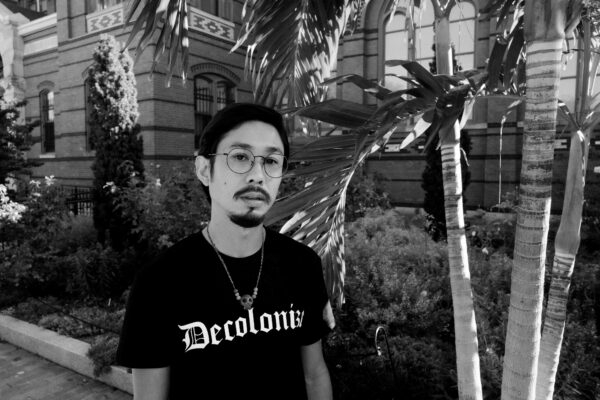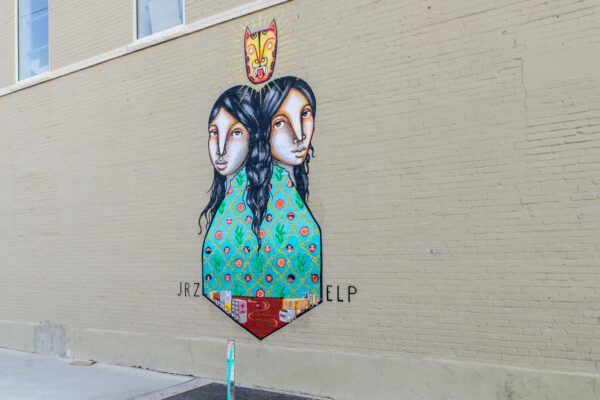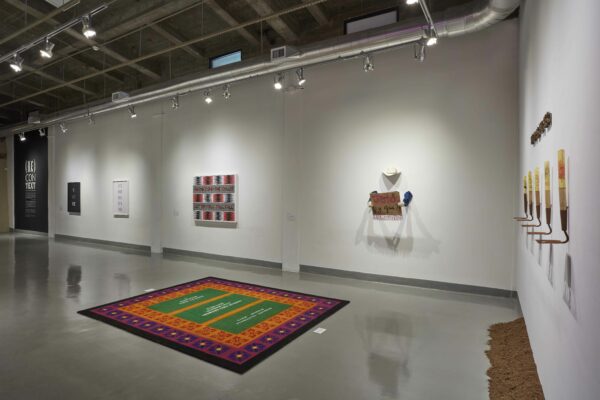Ramon Cardenas is the inaugural Assistant Curator of Practice at the Stanlee and Gerald Rubin Center of the Visual Arts at the The University of Texas at El Paso. He is a Filipino-American curator, visual artist, muralist, and printmaker, and is one half of the artistic collaboration LxsDos, with his wife Christian Pardo Cardenas. Ramon has worked with and collaborated with artists, organizations, and institutions such as the City of El Paso Public Art Program, Coachella Music Festival, and the Hirshhorn Museum and Sculpture Garden through the Smithsonian Latino Museum Studies Program (LMSP) in Washington, DC.
Nicolas Silva (NS): Could you tell us about how your art making career started? What styles or techniques have you been drawn to and inform your current practice?
Ramon Cardenas (RC): Growing up, I didn’t consider myself an artist. I didn’t have the skills of drawing realistically. I started getting into art later on in life in my high school years, in the early 2000s, when street art was beginning to emerge. I was inspired by artists like Shepard Fairey and Swoon, who used handmade posters and stickers and put them up in the public space amongst advertising.
Then, I started learning more about Taller de Gráfica Popular. They are a print collective based in Mexico City that started in 1937 after the Mexican Revolution. Their work addressed the social and political issues of the time and focused on working class and everyday people. Also, Mexican muralism and how artists were able to paint grand images that were accessible to the public. They also told the story of Mexican history.
NS: The El Paso/Juárez border region has a rich history and future of muralism. Could you tell us about creating your first mural?
RC: We, Lxs Dos, first started by putting stickers and posters on the streets. That later evolved into more large-scale permanent works, such as Sister Cities in 2015, which we completed through a small grant from the City of El Paso and community support. That was a part of a series of murals and an exhibition, MakeShift, we created that was inspired by everyday people of the border. The pieces were installed in the downtown and Segundo Barrio neighborhoods, which are in close proximity to the El Paso-Juárez border. It was important for us to install this series of works close to the border so that the public has access to the artwork.
NS: What led you to pursue a degree in Art History with a minor in Museum Studies?
RC: I decided to study Art History and Museum Studies because I wanted to pursue a career in the museum field and as an arts administrator in order to create opportunities for BIPOC (Black, Indigenous, People of Color), AAPI (Asian American and Pacific Islander), LGBTQ+, and other artists who have been historically underrepresented and exploited in museums, galleries, and art history.
NS: The Stanlee and Gerald and Rubin Center for the Visual Arts provides a fertile space for volunteers and visitors of all ages, including artists, thinkers, and curators. You recently were awarded the Community Curator position, and once you graduated you were promoted to Assistant Curator of Practice thanks to a generous grant from the Mellon Foundation. How does it feel to be part of the Rubin, given all your experiences and perspectives, especially after the Smithsonian Latino Museum Studies Program (LMSP)?
RC: It’s been an amazing opportunity to work with the Rubin Center throughout the years. Starting off as a part-time student intern to now being an Assistant Curator of Practice, I have learned so much. For example, the many aspects of working in the museum field, such as planning and executing exhibitions, loan forms, shipping needs, and working directly with artists and galleries. We’ve done projects with youth in summer camps. We work closely with paid student interns, providing real-life professional experiences. My time with the LMSP program gave me insight on large-scale state of the art institutions and an appreciation for the Rubin and what it has to offer for our region, especially with its focus on contemporary art.
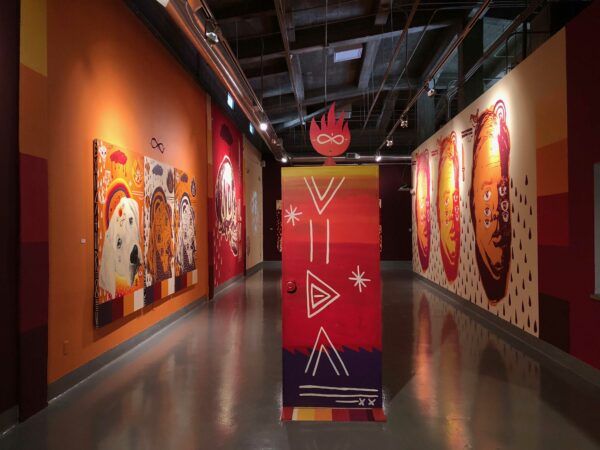
Jellyfish Colectivo “Manipulation , installation,” 2021, at the Rubin Center for the Visual Arts. Photo: Ramon Cardenas
NS: Do you have any key takeaways from your experience at the Hirshhorn you would like to share?
RC: There were so many great experiences during my time there. One of the main takeaways from that experience was working closely with my mentors, Tiffany McGettigan, Head of Education, and Marina Isgro, Associate Curator of Media and Performance Art. The project gave me the chance to develop educational programming to coincide with an exciting upcoming exhibition. I was able to implement my ideas while working closely with my mentors. I felt my contributions were supported and valued. Seeing how they included museum education this early in the exhibition planning process was great insight into how education and curatorial teams can collaborate to create holistic and meaningful programs for visitors of all ages. I also had the chance to meet other Hirshorn and Smithsonian staff, and get their important perspectives on the museum field.
NS: How has it been being an artist-curator-husband-father? Does your son contribute to the art making process? Is LxsDos taking a break with your new role, or is there something we should be on the lookout for?
RC: It’s been rewarding, life changing, and exhausting. He definitely has an eye for art. Every time we are working on a painting he always wants to join us. He loves colors and he definitely inspires us in everything that we do. I wouldn’t say LxsDos is taking a break, but we have to manage our time and projects accordingly. We can’t do as many projects as we used to. Right now, we are working on some painting commissions and an upcoming exhibition that we are curating. We enjoy collaborating with other artists creating posters, book covers, murals, and illustrations.
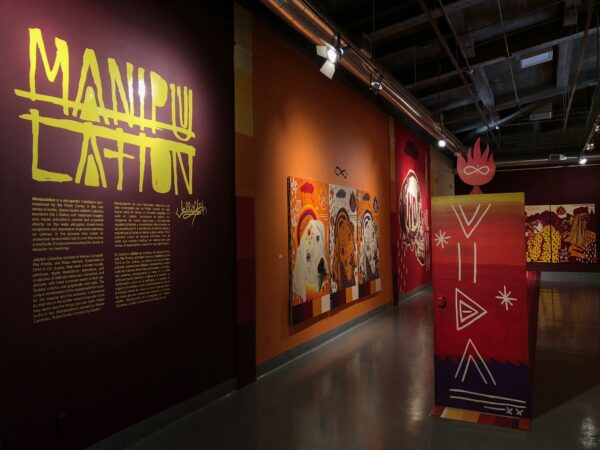
Jellyfish Colectivo “Manipulation , installation,” 2021, at the Rubin Center for the Visual Arts. Photo: Ramon Cardenas
NS: Thinking back to collaborations you have done, I think of the LxsDos illustrations for Gris Muñoz’s Coatlicue Girl and Manipulation by Jellyfish Collectivo (February 5 – April 16, 2021). It was a very successful show at the Rubin Center, bringing border voices into a space which has historically seen more artists living far away from the region, like Tomás Saraceno and Gaku Tsutaja, who exhibited highly salient shows. It makes sense that as a curator local to the area, you have the cultural and community scope to bring emerging and under-shown artists to the forefront. What was the process like for coming up with the show and executing it?
RC: The process happened very organically. We had many scheduling changes due to COVID-19, which freed up space in the gallery leading to the opportunity to show local artists in the space. Kerry Doyle, the Director, gave me the opportunity to curate the artist we were going to work with. I immediately thought of working with Jellyfish Collectivo, based on their previous work with large-scale installations, including street art and murals in Juárez.
Within a short amount of time they came up with the exhibition concept, Manipulation, and transformed the space with their trademark vibrant colors, murals, wooden sculptures, and paintings on canvas. One of the issues that came up during that show was that not everyone in the collective was able to travel due to border closures. We created a three-hundred sixty degree online tour version, since the exhibition was closed to the public for almost half the duration of the show.
NS: (RE)CONTEXT: Artists Reconstructing Words (closed December 9, 2022) was a very important show for the region, with integration of text-based works and relevant themes. Could you talk about that project and how the audience engaged with the work? In a curator talk, you mentioned working with Kerry Doyle, the Director of the Rubin. How was it working with her, but also finding your own curatorial voice?
RC: (RE)CONTEXT started when Kerry approached me to do this show with the theme of text-based art. I developed it to incorporate contemporary artists that I was interested in working with who use words in different types of mediums. I had the freedom to choose the types of artists I wanted to work with. Many of them have never exhibited in the region, which is important for our mission. Artists like Hank Willis Thomas, Jeffrey Gibson, Gabriella Sanchez, Patrick Martinez and Alina Kiliwa. The lenticular prints by Hank Willis Thomas, I am you, you are me (2020) and It’s not me, it’s you (2010) engaged the viewers in the space, depending on their point of view — the message and the meaning changes, which speaks a lot about our current dynamic on the border.
There was another powerful work by Nery Gabriel Lemus, titled Querida Niña Migrante (2020), that uses 15 welcome mats designed to look like the intricate sawdust carpets created in Guatemala. It’s hard to gauge the audience engagement, because I was out of town for my LMSP internship, but I got great feedback from the community, University of Texas at El Paso faculty, and their students, especially from opening night.
Kerry is like a mentor to me. She’s really given me the support, resources, and freedom to explore my curatorial voice, but has also give critical feedback and knowledge in the process of curating.
NS: Given that the Rubin’s tagline is “where contemporary art meets contemporary life,” what kind of changes or programming do you foresee happening in your tenure as Assistant Curator?
RC: I see the Rubin Center expanding our programming to focus more on border artists, incorporating them more into exhibitions, programming, workshops, and professional experiences. For instance, expanding and continuing our Community Engaged Mural Project, where we worked with University of Texas at El Paso students to create a mural inside of the Annunciation House, which is a volunteer organization that offers hospitality to migrants, immigrants, and refugees. We intend to continue to bring contemporary international artists to our region, exposing our student body and local community to the dynamic and unique work being made today.
NS: The University of Texas at El Paso (UTEP) Faculty Biennial Study is what you do with other people, along with Laura Turon’s solo exhibition Immersive Abstractions, recently closed. A lot of energy and work filled the galleries, from graphic design to ceramics to painting, drawing, printmaking, video, large-scale sculptures, and wearable art. Could you walk us through some of the pieces?
As an aside, I am totally celebrating the young professors in the room: Marianna T., Olague, Haydee Alonso, Ale Carrillo-Estrada, Dina Perlasca, and Nabil Gonzalez.
RC: Some of the pieces I was most drawn to include the mixed media ceramic works of Dina Perlasca, which resemble domestic household items and plants, and a series of miniature monument-like ceramic pieces by Vincent Burke, installed directly onto the wall, which was a unique way to display the works.
Also included was an oil painting by Mariana T. Olague, who paints people she knows personally. I love her use of color. She uses bright and saturated tones to emphasize her subjects. I feel the light source in her work represents the intense sunlight particular to this region.
NS: I was recently talking to a dance professor and scholar visiting El Paso and they mentioned how lovely the city is. How do you relate to the idea that El Paso is gaining traction in the creative fields, and what do you think needs to happen in the next decade for the city?
RC: Yes, I feel El Paso has so many talented artists. I think what we need to do is build an artistic infrastructure that includes more independent gallery spaces that are supported by the community. More support in the form of patrons and collectors. Projects and spaces like Azul Arena in Juárez and the Falstaff in El Paso have great ideas, but they need recognition and support so they don’t close down, which is a trend in most art spaces here.
NS: In your off time, what have you been reading, looking at, watching, and experiencing?
RC: Being a father and having a family, on my off time I usually like to sleep and rest. But I do like spending time alone and with my family at museums. I haven’t been able to do a lot of reading lately, but I started reading Curatorial Activism by Maura Reilly. I’ve been revisiting Art On My Mind by bell hooks. The last movie I saw was Wakanda Forever.
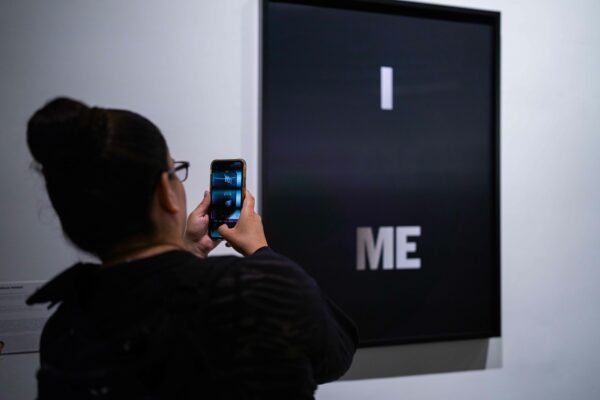
Hank Willis Thomas’ work in “(RE)CONTEXT,” 2022, at the Rubin Center for the Visual Arts. Photo: Viridiana Villa.
NS: El Paso is very lucky, being driving distance from Albuquerque, Marfa, Las Cruces, and Juárez, MX. The southwest is truly a hub. Do you get to get out as much as you’d like, and if you do, how does it inform your artistic and curatorial practice?
RC: In my new role, as Assistant Curator of Practice, I have been able to travel more than ever. These past few months I have been able to visit Art Week in Mexico City, checking out ZONA MACO, Salon ACME, and Feria Material. Just recently I was in Santa Fe for the Desierto Mountain Time gathering, which included regional institutions and museums such as SITE Santa Fe, The Santa Fe Art Institute, NMSU Art Museum, 516 Arts, the Roswell Museum, El Museo De Arte Ciudad Juárez and the Rubin Center.
It is important for me to travel and visit institutions, galleries, museums, and independent spaces and talk to curators, artists, community members, and art supporters. For me, this is research, seeing how different places install work and resolve their space; it’s my chance to see how their programs engage their communities. This process informs my practice at the Rubin Center.
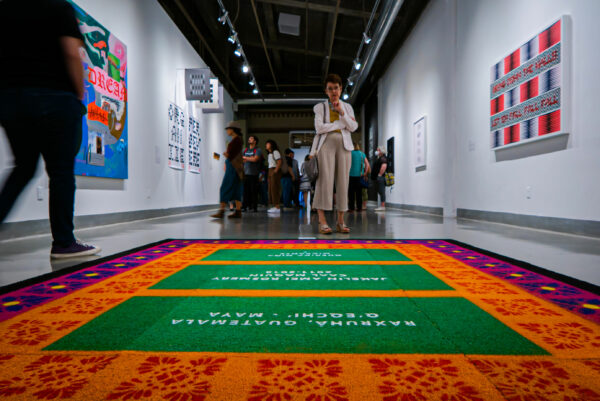
Nery Gabriel Lemus’ work in “(RE)CONTEXT,” 2022 at the Rubin Center for the Visual Arts. Photo: Viridiana Villa
NS: Anything else to add?
RC: Right now, I am currently working on the 2023 Annual Juried UTEP Student Art Exhibition, which is opening May 5, 2023 [the show closed on June 24], and developing exhibitions with border artists in our Project Space.
Nico Silva is a PhD student in Interdisciplinary Health Sciences, licensed master social worker, artist, and writer who envisions a world where the arts and artists are supported to their highest potential.


